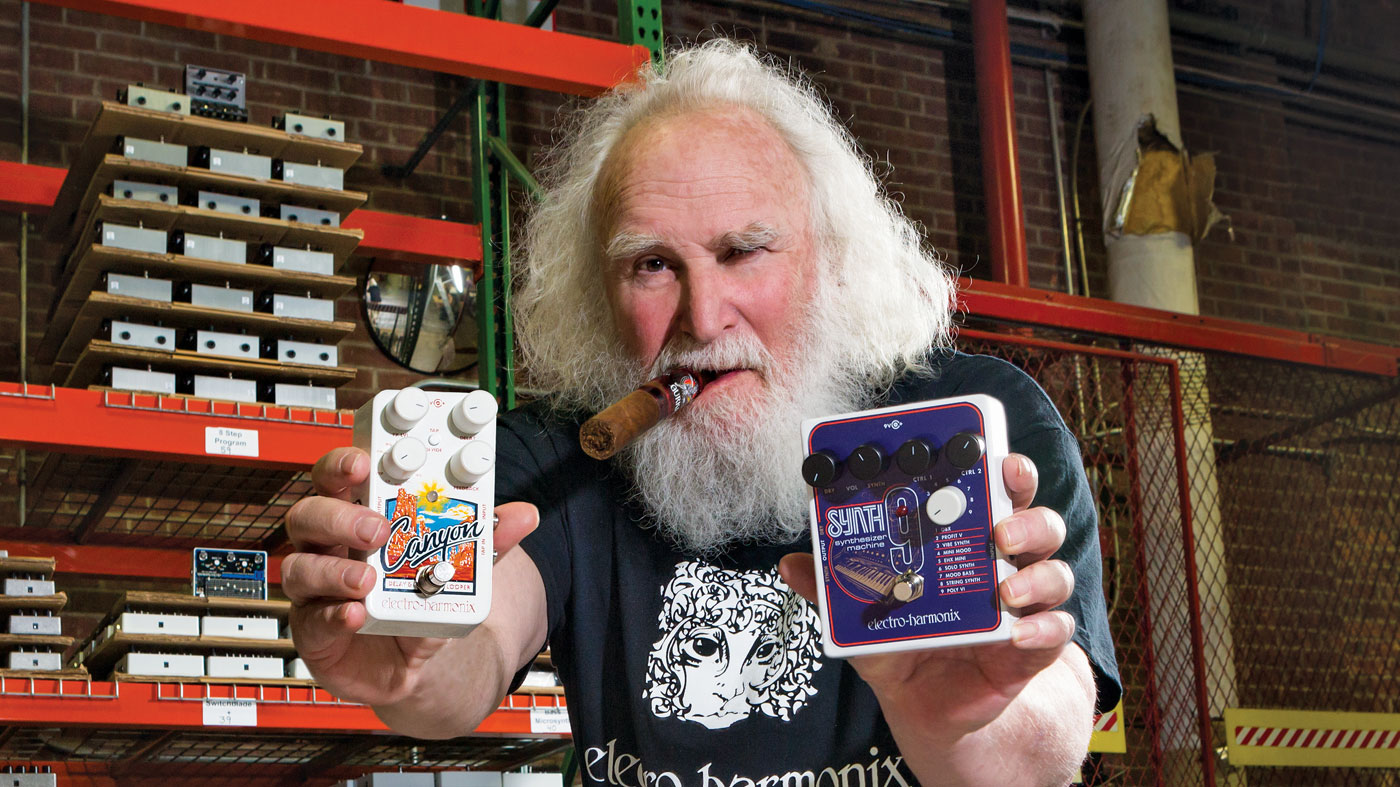
We talk about effects units old and new with Electro-Harmonix’s charismatic founder.
1. What was the first pedal you built and how did the design come about?
“The first pedal that I built under Electro-Harmonix was in late 1968 and it was the LPB-1 Linear Power Booster. I hooked up with a guy from Bell Labs who was working on a distortion-free sustainer, and when I went to check out the prototype I saw a little box plugged into the front of the amp.
“I asked him, ‘What’s that?’ and he said, ‘Well, I didn’t realise the guitar put out such a low signal, so I just built a simple one-transistor booster to stick in the front.’ When I hit the switch all of a sudden the amp was so loud! I said, ‘Wow! That’s a product!’”
2. What’s your best-selling pedal and why do you think that is?
“In terms of combined total units, it’s the Big Muff [variants], but our biggest single seller at the moment is the Canyon.
“In terms of gross dollars, at the moment it’s a combination of our 9-series pedals. All of them use the same circuit board - they just have different software. They’re designed by the great British designer - who I think is the best in the world - David Cockerell.”
My philosophy is to keep it balanced between a mix of simple products and some more complex designs
3. What makes Electro-Harmonix effects unique?
“My philosophy is to keep it balanced between a mix of simple products and some more complex designs, but not going overboard with the complexity and carrying on adding stuff to it - that can really muck up the software. Also, I like building in some extra special sounds at the edge of the controls. Some companies hate spurious noise, but I like to let the user decide - they can always back off a little bit if they want to.”
4. Which notable players/bands have used Electro-Harmonix pedals over the years?
“[Carlos] Santana bought a Big Muff from me using mail order with a Santana cheque and letterhead back in 1971! The Edge uses our Deluxe Memory Man; in fact, he just called up and got a special version - our 1,100-millisecond Memory Man [1100- TT]. Kurt Cobain used our Polychorus and Small Clone.
Want all the hottest music and gear news, reviews, deals, features and more, direct to your inbox? Sign up here.
“Jimi Hendrix used a Big Muff in 1969; Manny’s [of New York] was the first store I sold Big Muffs to and he bought one of the first ones from there. [Jimi] invited me to hang out at a recording session and there on the floor he had the Big Muff he bought at Manny’s!”
5. What’s new on the horizon for Electro-Harmonix effects?
“The really hot stuff we just brought out is the Canyon, which has 10 different delays, and the Synth9, which has different types of synthesiser sounds. We just came out with a pedal called the Platform, which is a fabulous ‘stereo out’ compressor/limiter that has some special features.”
6. Can you share your best tone tip?
“A lot of the feeling when you’re playing guitar comes from the attack of the strings; it’s that first fraction of a second - those short-lived high frequencies - that have a lot of the feeling. The audience might not hear it, but the guitarist who’s playing it senses it and feels it, and the more they feel, the better they play!”
7. Name some common mistakes that guitarists make with effects…
“I don’t know. I mean, I guess everybody’s a little different… Not using Electro- Harmonix pedals for all of their effects - that’s the biggest mistake [laughs]!”
8. What’s your favourite vintage pedal and why?
A lot of the feeling when you’re playing guitar comes from the attack of the strings; it’s that first fraction of a second
“Basically, I like making and coming out with new effects, so my favourite is what sells! Period. The Big Muff we brought out in 1969 and I still sell thousands of them a month and it’s my favourite because of that! We still sell a lot of LPB-1s. The transistors are different, but other than that the circuit is the same.”
9. What are your favourite effects moments on record and why?
“Back in the 70s I became friendly with [Steely Dan guitarist] Elliot Randall and the [CBS Orchestra] bass player Will Lee. They gave me this instrumental album they recorded using only Electro-Harmonix effects!”
10. What pedal problems do you think effects designers have yet to crack?
“True polyphonic pitch extraction. I mean, eventually as microprocessors get faster and faster there’ll be better algorithms you can build, but there’s always a problem with bass frequencies because of the long wavelength. There’s a time lag in order to capture what that frequency is, so the latency can be a problem, but we get around that in certain ways.”
Guitarist is the longest established UK guitar magazine, offering gear reviews, artist interviews, techniques lessons and loads more, in print, on tablet and on smartphones
Digital: http://bit.ly/GuitaristiOS
If you love guitars, you'll love Guitarist. Find us in print, on Newsstand for iPad, iPhone and other digital readers


